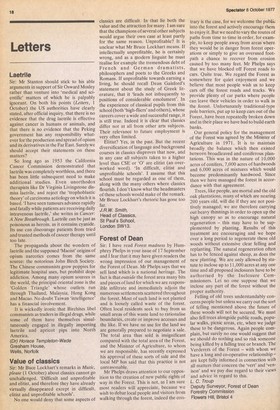Forest of Dean
Sir: I have read Forest madness by Humphrey Phelps in your issue of 17 September and I fear that it may have given readers the wrong impression of our management of the Forest of Dean. Mr Phelps says that we sell land which is a national heritage. The fact is that outside the forest area many bits and pieces of land for which we are responsible infiltrate and immediately adjoin the numerous settlements scattered throughout the forest. Most of such land is not planted and is loosely called waste of the forest. Often local residents seek to buy from us small areas of this waste land to rationalise boundaries, create or improve accesses and the like. If we have no use for the land we are generally prepared to negotiate a sale. The total area thus sold is insignificant compared with the total area of the Forest, and the Minister of Agriculture, to whom we are responsible, has recently expressed his approval of these sorts of sale and the local MP has said that this practice is not unreasonable.
Mr Phelps draws attention to our opposition to the creation of new public rights of way in the Forest. This is not, as I am sure most readers will appreciate, because we wish to debar local people and visitors from walking through the forest, indeed the con trary is the case, for we welcome the publie into the forest and actively encourage them to enjoy it. But we need to vary the routes of paths from time to time in order, for example, to keep people away, from areas where they would be in danger from forest oper ations or simply to give an overused footpath a chance to recover from erosion caused by too many feet, Mr Phelps says that we have blocked off Forest roads to cars. Quite true. We regard the Forest as somewhere for quiet enjoyment and we believe that most people wish us to keep cars off the forest roads and tracks. We provide plenty of car parks where people can leave their vehicles in order to walk in the forest. Unfortunately traditional-type pole barriers, put up to keep cars out of the Forest, have been repeatedly broken down and in their place we have had to build earth banks.
Our general policy for the management of the Forest was agreed by the Minister of Agriculture in 1971. It is to maintain broadly the balance which then existed between broadleaved and coniferous plan tations. This was in the nature of 10,000 acres of conifers, 7,000 acres of hardwoods and 6,000 acres of mixtures which would become predominantly hardwood. Since then we have managed the forest in accordance with that agreement.
Trees, like people, are mortal and the old oak plantations, many of which are nearing 200 years old, will die if they are not posi tively managed; we are therefore carrying out heavy thinnings in order to open up the high canopy so as to encourage natural regeneration — this may have to be supplemented by planting. Results of this treatment are encouraging and we hope over a long period to regenerate these old woods without extensive clear felling and replanting. The natural regeneration often has to be fenced against sheep, as does the new planting. We are only allowed by sta tute to inclose up to 11,000 acres at any one time and all proposed inclosures have to be authorised by the lnclosure Com missioners. Let no one suppose that we inclose any part of the forest without the proper authority.
Felling of old trees understandably concerns people but unless we carry out the sort of felling mentioned above the future of these woods will not be secured. We must also fell trees alongside public roads, popu lar walks, picnic areas, etc, when we judge these to be dangerous. Again people complain, but surely no one would suggest that we should do nothing and so risk someone being killed by a falling tree or branch. The Verderers of the Forest — with whom we have a long and co-operative relationship — are kept fully informed in connection with all matters that concern the 'veil' and 'venison' and we pay due regard to their views and advice in regard to this.
L. C. Troup Deputy Surveyor, Forest of Dean Forestry Commission Flowers Hill, Bristol 4


































 Previous page
Previous page